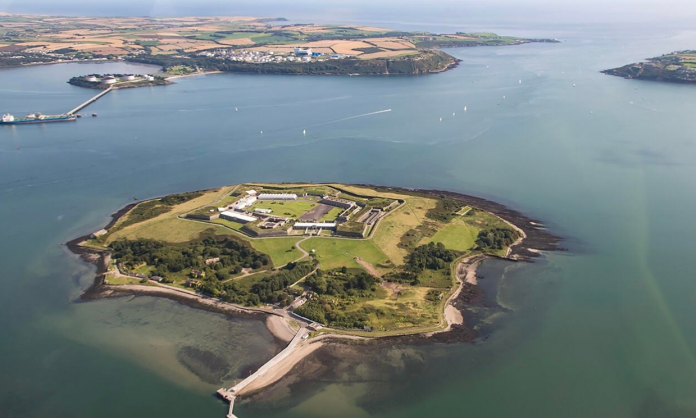By Gerry Coughlan
Spike Island, branded ‘Ireland’s Alcatraz’ has become one of Ireland’s most successful visitor attractions. The island of 103 acres (42 hectares) usurped some of the biggest sites in global tourism by being named Europe’s latest tourist attraction in 2017 – assigned the accolade at the World Travel Awards 2017 in St Petersburg, Russia.
There were 81,000 visitors to the island during 2019, a 21 percent increase on 2018 numbers. Spike Island was originally a monastic settlement and is home to Fort Mitchel, a 200-year-old fortress that once held over 2,300 prisoners, making it the biggest jail in Britain’s history.
Saint Mochuda founded a monastery there in the 7th century. A grant to Saint Thomas’s Abbey in Dublin in 1178 of the Church of Saint Rusien on Spike Island points to a monastic settlement as the name and date indicate a Celtic foundation. The ruins of a church were there in 1774. The star-shaped fortress opened to the public in 2015 and €6m by Cork County Council and Fáilte Ireland paved the way for tourist facilities.
Reached by a 10-minute ferry from Cobh, visitors to Spike island are taken on a guided tour through the 1,300-year history once home to a 7th century monastery before a 3,000-capacity star shaped fortress was built in the early 1800s. The fortress became the largest prison in Great Britain in the 1850s when its numbers swelled to over 2,000. The prison closed in 1883. The British army resided there for 55 years before a handover to the State in 1938.
The Irish army and navy used Spike and its fortress over the next 47 years before becoming a prison once again. The prison closed in 2004. “In the mid-19th century, Spike was not only the largest prison in the world, with 2,300 inmates, but also a place of severe punishment, of hard labour, strict discipline and religious instruction,” said Spike Island’s lead tour guide.
“That’s why it quickly became known as ‘Ireland’s Hell’ and ‘Hell on Earth’.” Irish convicts awaiting transportation to Australia were tied together by ball and chain and forced to labour with shovels and pickaxes. The stones they collected in wooden carts were so heavy it took 18 men to pull them. Life was infinitely worse inside. Inmates were held in solitary confinement within a purpose-built punishment block.
They were heavily chained to the wall of their cells; slept on cold, damp stone floors; and clothed in black from head to toe including a hood with only narrow slits for eyeholes. Prisoners not held in solitary confinement were crammed 12 to a cell; overcrowding, malnutrition and poor sanitation meant fatal diseases and mental illness were rife.
“The prisoners are like a menagerie of wild animals that snarl and fight in defiance of their keepers,” wrote prison chaplain Charles Bernard Gibson in 1863. More than 1,200 men died on the island. Prisoners were sent to Spike as a direct consequence of the Great Famine of 1845-49, often for petty crimes such as vagrancy and theft. In 1921, during the War of Independence, 600 republicans were held – a few even escaped.
On April 29th 1921 three men made a daring escape: Seán MacSwiney, Tom Malone and Con Twomey escaped and were picked up by members of a Cork branch of the IRA based in Cobh. Richard Barrett was held there but made good his escape in November of 1921 along with Moss Twomey, Henry O’Mahoney, Tom Crofts, Bill Quirke, Dick Eddy and Paddy Buckley. During the riot of 1 September 1985, rioting erupted when the few officers on duty were quickly overpowered as Block A, one of the accommodation blocks, caught fire and was destroyed. Rioting prisoners armed with slash-hooks and knives took control of the pier. Gardaí landed in force ending the riot.
Unlike Alcatraz, Spike Island had few famous prisoners. Dublin crime lord Martin Cahill, aka ‘The General’ served four months in Spike Island for ‘breaching the peace’. As he was being escorted from the pier in Cobh he harrumphed ‘Que Será, Será’ – what will be, will be. The late Martin Cahill was peaceful during his detention there, keeping out of sight and engaging in school classes, painting and plastering. The prison finally closed its doors in 2004.
Spike Island stands as an extraordinary microcosm of Irish history over the past 1,300 years. Visitors will find something to resonate with in its 1,300 years of history. They can wander through the remains of the island village and imagine growing up on an island complete with its own school, church, fortress and prison.
They can walk the corridors of the prison and stand in the cold, damp cells, patrol the perimeter of the fortress which heretofore defended Cork harbour from a flotilla of invading ships. What is unique about Spike Island is that there are no cars; nobody’s living there, so there are no dogs barking or car horns honking. It really is a peaceful sanctuary where one can get away from the mainland and contemplate.
Letters and diaries kept by Republican prisoners are one of the highlights of the Spike Island tour. The Old Cork in Colour exhibit is running in Spike Island until November 2022. Spike Island is a sleeping giant and successfully treads the fine line between education, entertainment and sensation. It is neither exploitative nor does it shy away from its dark past. Ireland’s Alcatraz seems wide awake now.
To reserve tickets visit: www.spikeislandcork.ie








